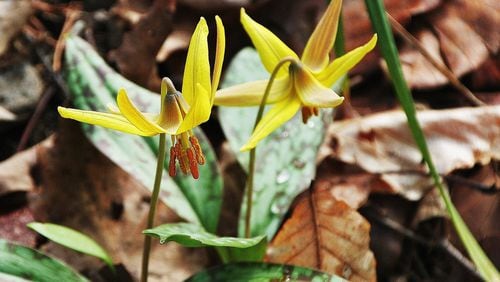Even though it’s still late winter, I mark the start of spring wildflower season when the trout lilies bloom, which is right about now. The Georgia Botanical Society, in fact, has field trips scheduled Sunday (Feb. 19) and next weekend expressly to see two of the state’s biggest wild trout lily populations.
Seeing a large patch of yellow-flowered trout lilies in full bloom can leave one breathless. That’s especially true for Sunday’s field trip destination, the 140-acre Wolf Creek Trout Lily Preserve in Grady County in southwest Georgia. With an estimated 30-40 million individual plants, the preserve is said to be the greatest expanse of trout lilies in the nation.
That is ironic, because trout lilies generally are uncommon in southwest Georgia. They mostly prefer North Georgia‘s mountains and Piedmont. A theory is that trout lilies migrated southward from the mountains tens of thousands of years ago. When the last ice age receded, they were left in spots in southwest Georgia and north Florida.
Expanses of blooming trout lilies also can be found around Atlanta over the next few weeks. The Georgia Botanical Society’s field trip on Feb. 25 will be to one of them, the Paces Mill unit in the Chattahoochee River National Recreation Area, where bright yellow trout lily blooms carpet the hillside above Rottenwood Creek in late winter.
The species growing in these places is the dimpled trout lily, whose preferred habitat is moist forests and bottomlands. Its leaves’ mottled coloring resembles trout skin, hence its name.
A less common species is the American trout lily, which occurs in moist forests of North Georgia.
Trout lilies belong to a wildflower group known as spring ephemerals, which bloom before trees put on leaves and shade the forest floor. By late spring, the ephemerals will be gone.
Trout lilies have another distinction: Their seeds are spread by ants, a process known as myrmecochory.
IN THE SKY: From David Dundee, Tellus Science Museum astronomer: The moon is in last quarter today. Mercury is low in the east just before sunrise. Venus and Mars are in the west at dusk and set about two hours later. Jupiter rises out of the east around midnight. Saturn rises out of the east about two hours before dawn.
About the Author






